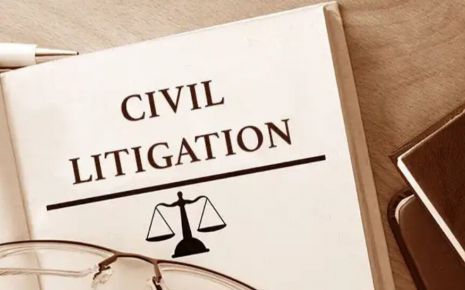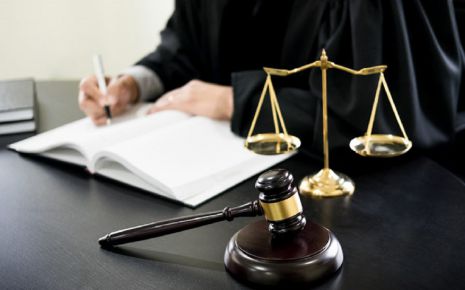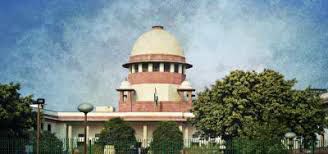Leterm Mortem
Evidence play a crucial role in courtrooms, it helps to concludes & solve
complexity in cases. Court of justice decided final order on the basis of
relevant facts which is admissible before the judge. Indian Evidence Act, 1872
make a provision for relevancy of facts admitted in courtroom section 6 to 55
deals with it.
Therefore leterm mortem means a dying declaration enshrined in section 32(1) of Indian evidence act or law of evidence which is under chapter 2 of this act and this chapter deals with relevancy of facts. another meaning is that dying declaration is relevant evidence before the court of trial. This blog is totally refers to concept of dying declaration which means words spoken or written by person before his / her death. Statement of deceased use as a evidera or evidence because a dying declaration is considered to be credible and trustworthy evidence based on general belief that a person who is on his deathbed will never lie.
Definitions
The term dying declaration has been derived from the word leterm mortem means 'words said before death' is based on legal maxim 'nemo moriturns proesumitur mentiri' (a man will not meet his god with a lie in his mouth).
The term 'dying declaration' has not been defined in Evidence Act, but section 32(1) deals with 'dying declaration' is a statement by declarant, who is unavailable to testify in court room due to his death. In another words dying declaration is a statement by a person who is dead or as to any circumstance of transaction which resulted in his death, in case in which his death come into question, such statement are relevant under section 32 of IEA,1872.
A deceased tells about his story or reason of his unnatural death to another person is called dying declaration.
A person or deceased speaks about circumstances of his or her death is properly known as dying declaration.
Whatever the statement in any form whether oral or written made by a person before his death which reveals the cause of his death or by whom his death is caused is a relevant evidence in front of presiding judge.
It is to be remember that, at the time of the declaration the person making the statement must be in a fit state of mind.
OBJECT BEHIND leterm mortem
The main object behind dying declaration - it is a presumption that a person who is about to die would not lie. It is also said that truth sits on the lips of a person who is about to die the victim is exclusive eye witness and hence this evidence should not be excluded.
Under section 32 Evidence Act Cases in which statements of relevant fact by person who is dead or cannot be found: Statement, written or verbal, or relevant facts made by a person who is dead, or who cannot be found, or who has become incapable of giving evidence, or whose attendance cannot be procured without an amount of delay or expense which, under the circumstances of case appears to Court unreasonable, are themselves relevant facts in the following cases:
Dying declaration is absolutely credible & admissible before the court.
Question & answers form
There is no particular form to be employed in making a dying declaration. It maybe oral or written or partly oral and partly written or maybe neither oral nor written, that is to say, it may consist of some sign or gestures made by deceased.
Under section 60 of IEA, 1872 generally oral evidence must be direct, oral evidence must in all cases whatever be direct. Therefore we concluded that hearsay evidence is irrelevant. But oral evidence of dying declaration is admissible in evidence as an exception to the general rule of evidence that hearsay evidence is no evidence in eye of law.
When magistrate writes a dying declaration, preferable it should be in question & answer form. The dying declaration not recorded in question & answers form cannot be discarded on that ground alone. Simply because the leterm mortem has not been recorded by a magistrate, it cannot be disbelieved.
A dying declaration can be recorded by a normal person. as in some circumstances where a judicial magistrate, police, and doctor is not available, then court cannot reject the statement which is recorded by a normal person.
A dying declaration made before a Judicial Magistrate has higher evidentiary value as he is presumed to know how to record a dying declaration and he is a neutral person. dying declaration was held to be suspicious[i].
A dying declaration written by Doctor is reliable. Where the dying declaration was recorded by doctor in question and answer form in the presence of other witnesses and it was corroborates with the testimony of other eye witness, it was held to be sufficient to convict the accused.
If doctor not present at the time of recorded dying declaration the dying declaration was recorded by executive magistrate before the employees of the hospital. The doctor is absent while recording of the statement of deceased. Mere absence of certificate of doctor was held to be not relevant and the conviction of the accused was proper.[ii]
Statement to police- The statement of a deceased as to cause of his death does amount to dying declaration. A clear and corroborated dying declaration cannot be rejected just only because it was recorded by a police officer[iii]
Therefore, dying declaration recorded by police during course of investigation is admissible under section 32 of evidence act.
In state of Karnataka v. sheriff [iv] the apex court held that dying declaration recorded by police officer could not be discarded solely on that ground. There is no requirement in law that dying declaration shall necessarily be recorded by magistrate.
Where a person injured and dies after lodging F.I.R., it is relevant as a leterm mortem.
In Kushal Rao V. State Of Bombay [v] SC held that multiple dying declaration can be relevant when it made without corroboration if regularity is maintained throughout the statement.
It applies to both homicide & suicide cases.
Section 32(1) of Indian evidence act, 1872 is applies to both situation i.e. homicide cases, suicide cases. Makes admissible a statement of a person who dies, whether the death is a homicide or suicide provided statement relates to the cause of death or exhibits circumstances leading to the death of the person making statement[vi]
In case najjan faruqui v. state of W.B[vii] such statement are relevant whether the person who made the statement was or was not at the time, when the statement was made, under expectation of death and whatever be the nature of the proceeding in which the cause of his death comes into question.
It does not limit the application of this rule to any particular proceeding. The proceeding may be civil or criminal. wherever the cause of that person's death is a point at issue, the statement will be admissible.
Difference between Indian law and English law
Exception:
Leading cases laws:
In Pakalanarain Swami v/s Emperor [viii] The deceased was a man of about 40. He had been a peon in the dewan of Pithapur. Pakala Narain Swami, the accused, was married to one of the daughters of dewan of pithapur. After marriage pakalana narain swami and his wife went to live at Berhampur about 250miles away from pithapur. In the year of 1993, they came back to pithapur and where they stayed with the dewan.
They seemed at that time to have been in need of money, and during 1936 the wife of the accused borrowed money from the deceased at various times an amount of Rs. 3,000. On Saturday 18th March 1937, the deceased received a letter from the accused inviting him to come that day or the next day to Berhampur.
The deceased left his house in order to go there and catch the train of Berhampur. He did not come back. On 23rd March 1937, the body of the deceased was found in steel trunk in the third class compartment at puri. The body has been cut into seven portions. The body of the deceased was identified by his widow. The accused was tried and convicted for murder and was sentenced to death.
During the trial, the widow of the deceased stated before the court that on the day her husband showed her a letter and said that he was going to Berhampur as the appellant's wife had written to him to come and receive payment of his dues.
The lordship of the privy council held that the statement related to the circumstances of the transaction which resulted in the death of the deceased so it was relevant. They also held that the statement made by the deceased that he was proceeding to the spot where he was killed or as to his reason for proceeding or that he was going to meet him would each of them be circumstances of the transaction.
However, circumstances must have some proximate relation to the actual cause and must be related to the transaction which resulted in death. For instance, in case of prolonged poisoning, they may be related to date at the considerable distance from the date of the actual fatal date. It is not necessary that there should be a known transaction other than the death of the declarant has ultimately been caused comes into question.
In the present case the cause of death comes into question, the transaction is one in which the deceased was murdered on 21th march or22nd march, the statement that he was setting out the place where the accused lived and to meet a person, the wife of the accused, who lived together with the accused's appears to be clear statement as of some transaction which resulted in his death.
Conclusion
At last I would like to conclude the blog here, there is no doubt anymore that dying declaration is relevant and admissible before court because of leterm mortem. dying declaration is a Piece of evidence got recognition before the court of justice, but there are some facts remember to make dying declaration admissible that a dying declaration which suffer from infirmity cannot form the basis of conviction.
Where the deceased was unconscious and could never make any dying declaration, the evidence with regards to it is to be rejected. The court has to scrutinize the dying declaration carefully and must ensure that the declaration is not the result of tutoring, prompting or imagination. Equally, merely because it is a brief statement, it is not to be discarded. If the court is satisfied that the dying declaration is true and voluntary, it can base conviction on it, without corroboration.
There is neither rule of law nor of prudence that dying declaration cannot be acted upon without corroboration. In cases of multiplicity of lertem mortem remember that all declaration made by deceased should be consistent with each other in same transaction. Thank you!
End-Notes:
Therefore leterm mortem means a dying declaration enshrined in section 32(1) of Indian evidence act or law of evidence which is under chapter 2 of this act and this chapter deals with relevancy of facts. another meaning is that dying declaration is relevant evidence before the court of trial. This blog is totally refers to concept of dying declaration which means words spoken or written by person before his / her death. Statement of deceased use as a evidera or evidence because a dying declaration is considered to be credible and trustworthy evidence based on general belief that a person who is on his deathbed will never lie.
Definitions
The term dying declaration has been derived from the word leterm mortem means 'words said before death' is based on legal maxim 'nemo moriturns proesumitur mentiri' (a man will not meet his god with a lie in his mouth).
The term 'dying declaration' has not been defined in Evidence Act, but section 32(1) deals with 'dying declaration' is a statement by declarant, who is unavailable to testify in court room due to his death. In another words dying declaration is a statement by a person who is dead or as to any circumstance of transaction which resulted in his death, in case in which his death come into question, such statement are relevant under section 32 of IEA,1872.
A deceased tells about his story or reason of his unnatural death to another person is called dying declaration.
A person or deceased speaks about circumstances of his or her death is properly known as dying declaration.
Whatever the statement in any form whether oral or written made by a person before his death which reveals the cause of his death or by whom his death is caused is a relevant evidence in front of presiding judge.
It is to be remember that, at the time of the declaration the person making the statement must be in a fit state of mind.
OBJECT BEHIND leterm mortem
The main object behind dying declaration - it is a presumption that a person who is about to die would not lie. It is also said that truth sits on the lips of a person who is about to die the victim is exclusive eye witness and hence this evidence should not be excluded.
Under section 32 Evidence Act Cases in which statements of relevant fact by person who is dead or cannot be found: Statement, written or verbal, or relevant facts made by a person who is dead, or who cannot be found, or who has become incapable of giving evidence, or whose attendance cannot be procured without an amount of delay or expense which, under the circumstances of case appears to Court unreasonable, are themselves relevant facts in the following cases:
- When it relates to cause of death.
- Or is made in course of business.
- Or against interest of maker.
- Or gives opinion as to public right or custom or matters.
- Or relates to existence of relationship.
- Or is made in will or deed relating to family.
- Or in document relating to transaction mentioned in section 13, clause (a).
- Or is made by several persons & expresses feelings relevant to matter in question.
Dying declaration is absolutely credible & admissible before the court.
Types of dying declaration
Recording of dying declaration in different form as follow:- Oral
- Written
- Sign or gestures
Question & answers form
There is no particular form to be employed in making a dying declaration. It maybe oral or written or partly oral and partly written or maybe neither oral nor written, that is to say, it may consist of some sign or gestures made by deceased.
Under section 60 of IEA, 1872 generally oral evidence must be direct, oral evidence must in all cases whatever be direct. Therefore we concluded that hearsay evidence is irrelevant. But oral evidence of dying declaration is admissible in evidence as an exception to the general rule of evidence that hearsay evidence is no evidence in eye of law.
Oral dying declaration is an exception to the rule of hearsay evidence
Any type of sign & gestures given by deceased person under circumstance of his death is admissible in eye of law. Because there are some circumstances under which a deceased person is not able to communicate to others during his last few minutes. Therefore whatever kind of gestures deceased followed is credible.When magistrate writes a dying declaration, preferable it should be in question & answer form. The dying declaration not recorded in question & answers form cannot be discarded on that ground alone. Simply because the leterm mortem has not been recorded by a magistrate, it cannot be disbelieved.
Condition to fulfill for admissible of dying declaration:
- The person making statement must have died.
- Injuries must have caused the death.
- Statement must have been made as to cause of his death or as to circumstances of the transaction resulting in his death.
- The cause of his death must be in question.
- The person making statement must be in a fit condition to make the statement.
- The statement must be complete.
- Declaration must be competent.
Who should record leterm mortem or dying declaration:
- Magistrate
- Person
- Police
- Medical examiner
A dying declaration can be recorded by a normal person. as in some circumstances where a judicial magistrate, police, and doctor is not available, then court cannot reject the statement which is recorded by a normal person.
A dying declaration made before a Judicial Magistrate has higher evidentiary value as he is presumed to know how to record a dying declaration and he is a neutral person. dying declaration was held to be suspicious[i].
A dying declaration written by Doctor is reliable. Where the dying declaration was recorded by doctor in question and answer form in the presence of other witnesses and it was corroborates with the testimony of other eye witness, it was held to be sufficient to convict the accused.
If doctor not present at the time of recorded dying declaration the dying declaration was recorded by executive magistrate before the employees of the hospital. The doctor is absent while recording of the statement of deceased. Mere absence of certificate of doctor was held to be not relevant and the conviction of the accused was proper.[ii]
Statement to police- The statement of a deceased as to cause of his death does amount to dying declaration. A clear and corroborated dying declaration cannot be rejected just only because it was recorded by a police officer[iii]
Therefore, dying declaration recorded by police during course of investigation is admissible under section 32 of evidence act.
In state of Karnataka v. sheriff [iv] the apex court held that dying declaration recorded by police officer could not be discarded solely on that ground. There is no requirement in law that dying declaration shall necessarily be recorded by magistrate.
Dying declaration in FIR
A report made by the deceased relating as to the cause of his death shall be relevant as a dying declaration under section 32(1).Where a person injured and dies after lodging F.I.R., it is relevant as a leterm mortem.
Complaint as dying declaration
Yes, dying declaration made in complaint before police officer is relevant under section 32(1) IEA, 1872.Statement under section 162 Cr.P.C.
If we look at the criminal procedure code there is one section related to statement to police use as a evidence, section 162 deals with it. Deep look at section 162(2) of Cr.p.c. says that, nothing in this section shall be deemed to apply to any statement falling within the provision of clause (1) of section 32 of IEA, 1872. Section 162 which prohibits the use of statement recorded under section 161 makes an exception in sub section (2). A statement of dying declaration recorded during investigation by investigation officer will be relevant under section 32(1).Language used in dying declaration
There is one point is also to remember that, recording the leterm mortem in the language of the maker. But it would not affect the evidentiary value of it because it was recorded in another language if the person recording it is well conversant into the language. But if dying declaration in distinct language suppose one in Marathi and another in Hindi and the deceased was proficient in both languages, dying declaration is admissible.Multiple dying declarations
A situation in which there is multiple dying declaration occur, a point to be remember that they are consistent with each other. If all the dying declaration are similar to each other and state correctly the cause of death, and there is no inconsistency or contradiction between the statement it can be admissible. But if there is a contradiction and overlapping between multiple dying declaration then court will cross-examine the facts of the case. There should be regularity in all the dying declaration.In Kushal Rao V. State Of Bombay [v] SC held that multiple dying declaration can be relevant when it made without corroboration if regularity is maintained throughout the statement.
It applies to both homicide & suicide cases.
Section 32(1) of Indian evidence act, 1872 is applies to both situation i.e. homicide cases, suicide cases. Makes admissible a statement of a person who dies, whether the death is a homicide or suicide provided statement relates to the cause of death or exhibits circumstances leading to the death of the person making statement[vi]
Proof of dying declaration
When dying declaration is verbal or written, it can be proved by examining the person in whose presence the statement was made. The person recording the statement is to be examined before the court and he will prove the writing before the court.Expectation of death
Section 32 does not require that the statement sought to be admitted in evidence should have been made in immediate expectation of death. Specially in India expectation of death is not necessary in dying declaration. Though the expectation of the death does not affect the relevancy of dying declaration.In case najjan faruqui v. state of W.B[vii] such statement are relevant whether the person who made the statement was or was not at the time, when the statement was made, under expectation of death and whatever be the nature of the proceeding in which the cause of his death comes into question.
It does not limit the application of this rule to any particular proceeding. The proceeding may be civil or criminal. wherever the cause of that person's death is a point at issue, the statement will be admissible.
Dying declaration incomplete
A dying declaration is inadmissible in evidence if it is incomplete.Difference between Indian law and English law
- In English law, a dying declaration is provable only in criminal cases .while in India law, it is provable both in civil and criminal cases.
- Under English law, the declarant must die without a ray of hope of survival. But according to second para of section 32(1) statement made not under the expectation of death are relevant and admissible.
- According to English law, the declarant must be competent. But in India law, every person whether major or minor is competent to make declaration.
Exception:
- Dying declaration should not be under influence of anyone.
- An inconsistent dying declaration is of no evidentiary value.
- If the deceased made statement before his death which is anything other than the cause of his death, then such declaration shall not be admissible in evidence.
Leading cases laws:
In Pakalanarain Swami v/s Emperor [viii] The deceased was a man of about 40. He had been a peon in the dewan of Pithapur. Pakala Narain Swami, the accused, was married to one of the daughters of dewan of pithapur. After marriage pakalana narain swami and his wife went to live at Berhampur about 250miles away from pithapur. In the year of 1993, they came back to pithapur and where they stayed with the dewan.
They seemed at that time to have been in need of money, and during 1936 the wife of the accused borrowed money from the deceased at various times an amount of Rs. 3,000. On Saturday 18th March 1937, the deceased received a letter from the accused inviting him to come that day or the next day to Berhampur.
The deceased left his house in order to go there and catch the train of Berhampur. He did not come back. On 23rd March 1937, the body of the deceased was found in steel trunk in the third class compartment at puri. The body has been cut into seven portions. The body of the deceased was identified by his widow. The accused was tried and convicted for murder and was sentenced to death.
During the trial, the widow of the deceased stated before the court that on the day her husband showed her a letter and said that he was going to Berhampur as the appellant's wife had written to him to come and receive payment of his dues.
The lordship of the privy council held that the statement related to the circumstances of the transaction which resulted in the death of the deceased so it was relevant. They also held that the statement made by the deceased that he was proceeding to the spot where he was killed or as to his reason for proceeding or that he was going to meet him would each of them be circumstances of the transaction.
However, circumstances must have some proximate relation to the actual cause and must be related to the transaction which resulted in death. For instance, in case of prolonged poisoning, they may be related to date at the considerable distance from the date of the actual fatal date. It is not necessary that there should be a known transaction other than the death of the declarant has ultimately been caused comes into question.
In the present case the cause of death comes into question, the transaction is one in which the deceased was murdered on 21th march or22nd march, the statement that he was setting out the place where the accused lived and to meet a person, the wife of the accused, who lived together with the accused's appears to be clear statement as of some transaction which resulted in his death.
Conclusion
At last I would like to conclude the blog here, there is no doubt anymore that dying declaration is relevant and admissible before court because of leterm mortem. dying declaration is a Piece of evidence got recognition before the court of justice, but there are some facts remember to make dying declaration admissible that a dying declaration which suffer from infirmity cannot form the basis of conviction.
Where the deceased was unconscious and could never make any dying declaration, the evidence with regards to it is to be rejected. The court has to scrutinize the dying declaration carefully and must ensure that the declaration is not the result of tutoring, prompting or imagination. Equally, merely because it is a brief statement, it is not to be discarded. If the court is satisfied that the dying declaration is true and voluntary, it can base conviction on it, without corroboration.
There is neither rule of law nor of prudence that dying declaration cannot be acted upon without corroboration. In cases of multiplicity of lertem mortem remember that all declaration made by deceased should be consistent with each other in same transaction. Thank you!
End-Notes:
- Subhash v. state of Haryana, AIR 2011 SC.
- Raju devande v. state of Maharashtra, AIR 2016 SC.
- Ram singh v. state delhi 1995 Cr.
- AIR 2003 SC 1074.
- AIR 1958.SC.
- Sharad v. state of Maharashtra, AIR 1984 SC.
- AIR 1998 SC.
- AIR 1939 PC.
Law Article in India
Legal Question & Answers
Lawyers in India - Search By City
LawArticles
How To File For Mutual Divorce In Delhi

How To File For Mutual Divorce In Delhi Mutual Consent Divorce is the Simplest Way to Obtain a D...
Increased Age For Girls Marriage

It is hoped that the Prohibition of Child Marriage (Amendment) Bill, 2021, which intends to inc...
Facade of Social Media

One may very easily get absorbed in the lives of others as one scrolls through a Facebook news ...
Section 482 CrPc - Quashing Of FIR: Guid...

The Inherent power under Section 482 in The Code Of Criminal Procedure, 1973 (37th Chapter of t...
The Uniform Civil Code (UCC) in India: A...

The Uniform Civil Code (UCC) is a concept that proposes the unification of personal laws across...
Role Of Artificial Intelligence In Legal...

Artificial intelligence (AI) is revolutionizing various sectors of the economy, and the legal i...








Please Drop Your Comments